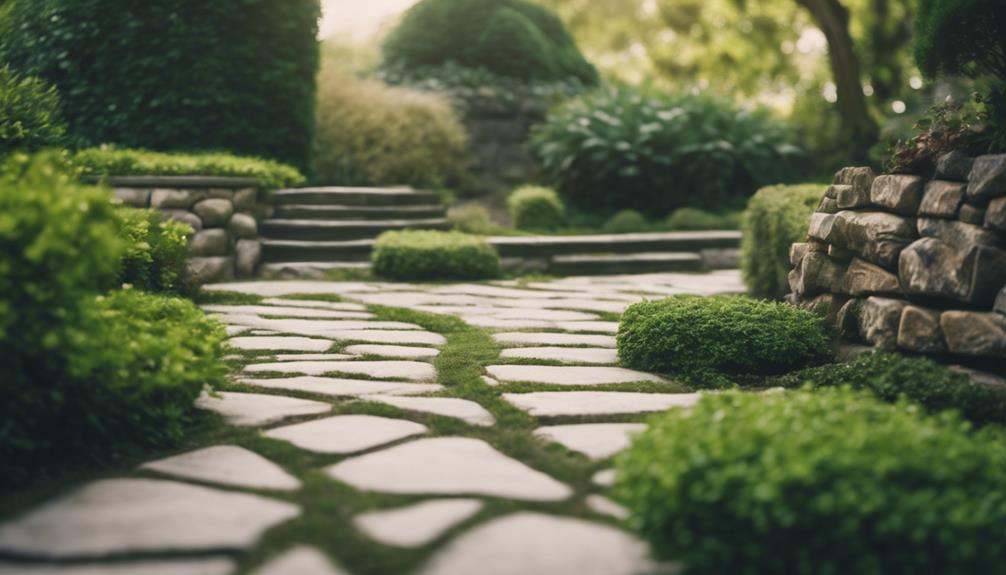Stone walkways enhance outdoor spaces with timeless charm and functionality. Embrace formal designs with straight lines directing towards focal points, or opt for informal layouts featuring sweeping curves. Choose from durable stone options like slate for high traffic areas, limestone for earthy hues, or sandstone for a non-slip surface. Address installation considerations such as drainage and winter scheduling to guarantee longevity. Consider costs ranging from $45 per square foot for pavers to $250 per slab for freeform designs. Curved paths create a casual feel, while combining straight lines adds visual intrigue. Tips for stone walkway design await!
Key Takeaways
- Choose durable stones like slate or sandstone for longevity and minimal maintenance.
- Consider curved paths for a casual feel and to visually expand small gardens.
- Opt for straight lines and right angles in formal designs to lead the eye.
- Prioritize safety by selecting non-slippery sandstone for walkways, especially in wet conditions.
- Address installation considerations like drainage and timing for durability and cost-effectiveness.
Stone Walkway Design Tips
When designing stone walkways, incorporating formal or informal styles can greatly impact the overall aesthetic of your outdoor space. Formal designs, characterized by straight lines and right angles, lead the eye to a focal point, creating a sense of structure and elegance.
In contrast, informal designs feature irregular patterns and sweeping curves, offering a more relaxed and natural appearance. Curved paths, commonly found in informal designs, not only create a casual atmosphere but also have the visual effect of making a small garden appear larger.
Whether you opt for the precision of formal lines or the organic flow of informal curves, selecting the right design style for your stone walkway can immensely enhance the beauty and functionality of your outdoor area.
Top Stone Types for Walkways
Which stone types are recommended for walkways to guarantee durability and aesthetic appeal?
When it comes to creating durable and visually appealing walkways, slate, limestone, and sandstone are highly recommended options.
Slate is known for its durability, making it ideal for high traffic areas.
Limestone offers earthy colors and is resistant to salt, ensuring longevity.
Sandstone, with its variety of colors, provides a non-slip surface even when wet. Additionally, sandstone is resistant to de-icing solutions and requires minimal maintenance over time.
Installation Considerations for Stone Walkways

Proper installation of stone walkways is essential for guaranteeing durability and longevity in outdoor spaces. When considering the installation of stone walkways, it is vital to assess factors such as shape, size, stone choice, and labor costs.
Formal walkways are generally less expensive to install compared to informal designs, but complex patterns may require specialized cutting and grading, impacting the overall cost. Before installation, it is important to check for any drainage issues that could impact the walkway's stability over time.
Additionally, scheduling the installation before winter can prevent ground shifting and secure a solid foundation. By addressing these considerations, you can create a beautiful and long-lasting stone walkway for your outdoor area.
Breakdown of Stone Walkway Costs
The cost breakdown of stone walkways provides insight into the pricing structure of various materials and components involved in creating these outdoor pathways. Stone stair treads are a fundamental component, starting at $150.
Stone pavers, which are common in walkway construction, begin at $45 per square foot. For those looking for a more natural look, freeform stone slabs are an option, with prices starting at $250 per slab.
It is worth noting that formal walkways tend to be slightly less expensive than informal ones. Additionally, complex designs that require reconstruction and specialized labor may incur higher costs.
Understanding these cost elements is essential for planning and budgeting when considering the installation of a stone walkway.
Tips for Designing Your Stone Walkway

When designing your stone walkway, consider the overall design and material that will best complement your backyard aesthetic. The choice of stone type, path shape, and installation method all play a significant role in creating a cohesive and visually appealing outdoor space. Here are some tips to guide you through the design process:
| Tip 1: Path Shape | Tip 2: Stone Type | Tip 3: Installation |
|---|---|---|
| Opt for curved paths for a casual look | Choose a durable stone like slate for high traffic areas | Guarantee proper drainage to prevent shifting |
| Use straight lines for a formal appearance | Consider salt-resistant limestone for longevity | Secure professional installation for complex designs |
| Combine straight and curved paths for visual interest | Select non-slippery sandstone for safety | Set up walkways before winter to avoid issues |
These tips will help you create a stunning stone walkway that enhances your outdoor space.
Frequently Asked Questions
How Can I Incorporate Lighting Into My Stone Walkway Design?
To enhance your stone walkway design with lighting, consider incorporating low-voltage LED fixtures for safety and ambiance. Strategically place fixtures along the path to illuminate key areas and create a welcoming atmosphere in your outdoor space.
Are There Any Eco-Friendly Stone Options for Walkways?
Eco-conscious homeowners seeking sustainable options for walkways can explore eco-friendly stone choices like permeable pavers made from recycled materials or locally sourced natural stones. Consider factors such as durability, maintenance, and environmental impact when selecting materials.
Can I Add Custom Patterns or Designs to My Stone Walkway?
Custom patterns and designs can enhance the aesthetic appeal of a stone walkway. Incorporating formal or informal styles, such as straight lines with right angles or sweeping curves, can create a unique and personalized look that complements your outdoor space.
What Are the Best Ways to Maintain and Clean Stone Walkways?
The best ways to maintain and clean stone walkways include regular sweeping and rinsing with water to remove debris. For tougher stains, use a mild detergent or specialized stone cleaner. Seal the stone periodically to protect it from wear.
Do Stone Walkways Increase Property Value?
Stone walkways can increase property value by up to 15%. They enhance curb appeal, create a welcoming entrance, and improve overall aesthetics. Choosing durable stone types and professional installation can maximize this investment.
Conclusion
In sum, stone walkways offer an impressive solution for both function and form in outdoor spaces. Selecting suitable stone types, carefully planning the design, and considering installation factors are key to creating a durable and visually appealing pathway.
By following these tips and understanding the costs involved, one can craft a mesmerizing and cohesive hardscape that enhances the overall landscape.










